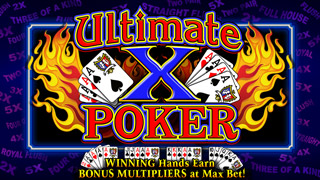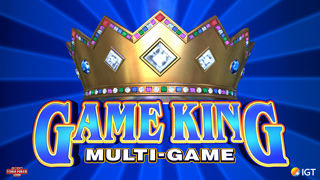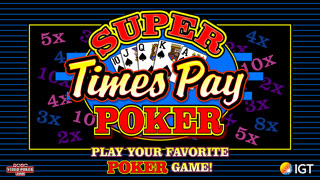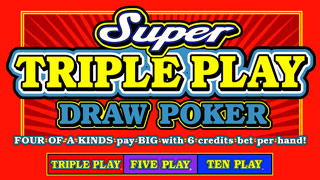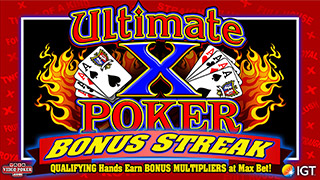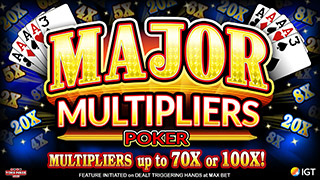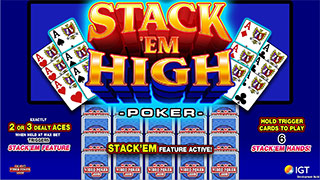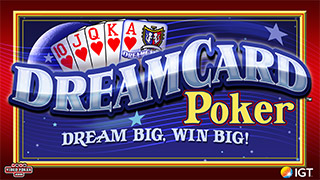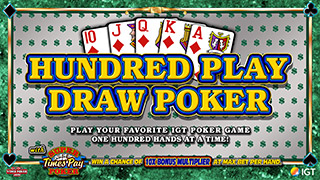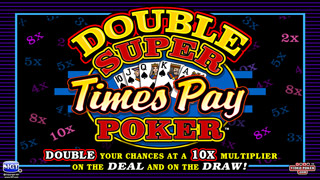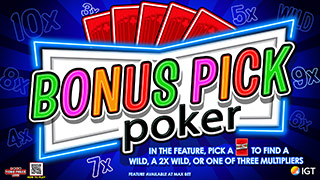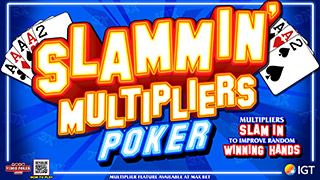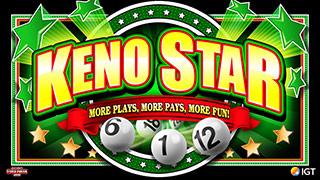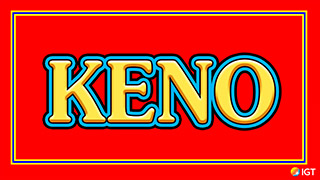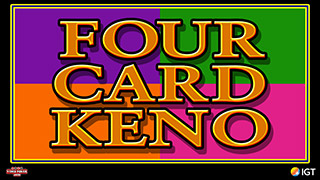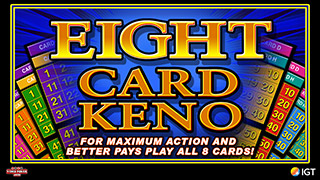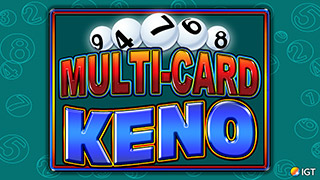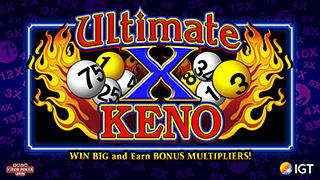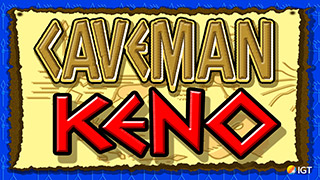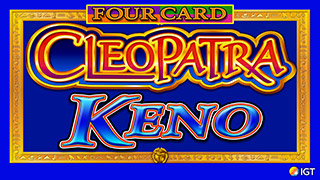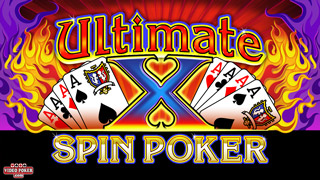Bankroll for single JoB vs 10 line JoB Super Times
-
klockman
- Forum Newbie
- Posts: 5
- Joined: Sun Sep 11, 2011 3:20 pm
Bankroll for single JoB vs 10 line JoB Super Times
I am new to video poker but not to gambling so i have basic idea about bankrolls but have a question. Here's what I am trying to do...any feedback is welcome and appreciated!
GOAL: I want to play 9/6 Jacks or Better at the $1 level (meaning $5/hand) and play until I get a Royal Flush.
THOUGHTS: After running many simulations using Wolf Video Poker I believe 6k will cover me stopping after receiving a Royal Flush or 40,000 hands. (see disclaimers below for more info on these simulations)
QUESTION: How does the bankroll requirement change to meet this same goal playing 9/6 Jacks or Better on a 10 line Super Times Pay machine? How about a 10 line Double Super TImes Pay machine?
QUESTION 2: Is there software available that will allow computer simulations of thousands of hands on a Super Times Pay machine so that I may answer the question above on my own?
DISCLAIMERS:
-I know it may be hard to find a 9/6 10 line machine but I am just curious how the bankroll requirements change.
-I ran 20+ simulations that ran through 40k hands. A good majority did not go below -$6,000 before hitting a Royal Flush or reaching 40k hands. If you think this is super misleading please let me know.
GOAL: I want to play 9/6 Jacks or Better at the $1 level (meaning $5/hand) and play until I get a Royal Flush.
THOUGHTS: After running many simulations using Wolf Video Poker I believe 6k will cover me stopping after receiving a Royal Flush or 40,000 hands. (see disclaimers below for more info on these simulations)
QUESTION: How does the bankroll requirement change to meet this same goal playing 9/6 Jacks or Better on a 10 line Super Times Pay machine? How about a 10 line Double Super TImes Pay machine?
QUESTION 2: Is there software available that will allow computer simulations of thousands of hands on a Super Times Pay machine so that I may answer the question above on my own?
DISCLAIMERS:
-I know it may be hard to find a 9/6 10 line machine but I am just curious how the bankroll requirements change.
-I ran 20+ simulations that ran through 40k hands. A good majority did not go below -$6,000 before hitting a Royal Flush or reaching 40k hands. If you think this is super misleading please let me know.
-
shadowman
- Video Poker Master
- Posts: 3587
- Joined: Mon Oct 23, 2006 5:42 pm
I assume you are playing the 10 play machines at $50/hand (same basic denomination). What happens is your variance increases because of the dealt hand factor. Overall this would increase the bankroll requirement although not significantly.
-
New2vp
- Video Poker Master
- Posts: 1878
- Joined: Mon Sep 11, 2006 4:02 am
k-man, Following are some results that might interest you. These are NOT simulations; unless you have many simulations, you generally are subject to considerable unknown experimental error because you never know for certain whether you simply got an unusual batch of results. Instead what I present below are exact calculations of probabilities of the events in which you stated interest. Certainly I could have had rounding errors or outright programming errors, so use them with utmost caution.A bankroll of $6000 will satisfy your goal about 85% of the time for single line, but you will need considerably more than that if you want that same probability for multi-line. How much more? It is difficult to say without repeated program runs with higher bankrolls. That same bankroll will be good for 10-play about 3/4 of the time, for 10-play STP 2/3 of the time, and for 10-play DSTP, 5/8 of the time.I am unaware of any commercial software that exists to solve these types of problems, though there are several products that perform some level of bankroll analysis and VPFW, offered elsewhere on this site, specifically deals with Super Times Pay (but not Double Super Times Pay).
Bankroll
$6,000
# of Hands
40,000
; 4,000 x 10 for 10-play
9/6 Jacks
or Better
Pr($ Left
Diff Amts
Max
# of Plays
Pr(Royal)
Pr(Bust Out)
after full play
Non-Royal
Max
Non-Royal
but no royal)
Wins/Play
Loss/Play
Win/Play
Single Line
40000
60.15%
15.22%
24.62%
9
-5
245
10-play
4000
56.25%
24.61%
19.14%
421
-50
2450
10-play STP
4000
53.88%
33.02%
13.10%
1603
-60
24940
10-play DSTP
4000
52.47%
37.74%
9.80%
3342
-70
49930
Min
Max
Possible
Min
Max
Odds of
Money
Money
Royal
Gross Win
Gross Win
Royal
After Bust
After Bust
Wins/Play
with Royal
with Royal
per Play
Single Line
$ 0
$ 0
1
4000
4000
1 in 40390.55
10-play
$ 0
$ 45
1590
4000
40000
1 in 4417.44
10-play STP
$ 0
$ 55
8548
4000
400000
1 in 4417.44
10-play DSTP
$ 0
$ 65
19835
4000
800000
1 in 4417.44
As you can see, if simply getting a royal flush is what you are most concerned with, your best chances will occur with single line. As shadowman said, you have to take into consideration that with multiline play, that first royal might be accompanied by another (or possibly 9 others if the royal is dealt). That would account somewhat for the lower probability of getting one royal; higher volatility and a higher chance of going bust is a factor as well.Of course since your limit of 40,000 hands is less than one royal cycle, the likelihood of getting a royal even with an unlimited bankroll is going to be significantly less than certainty (a probability somewhere in the low 60%'s for single line).I presumed that you would play only 4000 games of 10-play, so that our limited number of hands (4000 x 10) would be comparable to 40,000 hands of single play.In performing this analysis, I used the exact probabilities of all non-royal payoffs per hand. As you can see the number of different possible payoffs increases from only 9 in single line (which includes a payoff of zero for garbage final hands) to well over 3000 when you consider the possible payoffs on each of 10 hands, all combinations thereof, and all the possible multipliers that can exist with Double Super Times Pay.One thing that made this analysis easier is that I did not consider how much was won when the first royal hit. For single line, this is trivial since the payoff would always be $4000, but it becomes a gradually more difficult problem as we proceed with the other games. For example, with DSTP, one could have won 19,835 different amounts (from $4000 to $800,000) with that first royal flush.One caveat with DSTP is that, although we know the average deal and draw multipliers are both 4.01, I do not know the exact probability distribution of the different multipliers that produce this average. In performing the calculations, I presumed that the distribution was fairly close to the STP distribution, which has a mean of 4.05.I also had to consider when exactly that we were busted. This is easy on single line since all bets are multiples are $5. We stop when we have exactly $0 remaining. However, on the 10-play machines when we bet $50, $60, or $70, we could end up with some amount more than $0 but still less than enough to make one full bet. I considered these times to be a bust. (With considerable more programming and trouble, I could make more complicated assumptions, but I doubt if the results would be significantly different in those cases and I know it would take considerably more programming and computing time to do so).The maximum non-royal win on a play is the NET win and (with 9/6 JoB) would involve a straight flush for single line ($250 won minus $5 bet), a dealt straight flush for 10-play ($250 x 10 hands won minus $50), and a dealt straight flush with maximum multiplier for the STP and DSTP games ($250 x 10 hands x 10 multiplier minus $60 or $250 x 10 hands x 20 multiplier minus $70, respectively).There are 3 key probabilities listed for each game:1. Probability of getting a royal flush and stopping.2. Probability of losing the entire bankroll (or at least enough of it to prevent being able to make another max-coin bet).3. Probability of having money left over at the end of 40,000 hands, but not having hit a royal flush.These three probabilities should add to 100%; the tiny 0.01% differences are due to rounding error.There is a greater probability in busting out in the STP and DSTP games due to the higher bet size. A bad run is more likely to damage your chances when you have to make larger bets if you do not get your share of multipliers and luck on the deal and draw. This is offset somewhat by the fact that STP increases the return of a game by a factor of 1.0028 and DSTP increases the return by a factor of 1.0050. I don't know if you have ever seen a DSTP 9/6 Jacks or Better game, but it has a theoretical return in excess of 100%.The numbers for STP and DSTP take considerable computing time (hours to half a day) but more complex programming analysis might be able to cut that down somewhat (though that is not planned).Now, what are you going to do with this info?? As Dancer used to close his columns, one idea would be to "go out and hit a royal flush!!"
-
jim18
- Senior Member
- Posts: 118
- Joined: Fri Mar 04, 2011 9:55 am
New2vpYou certainly have done a fine job of explaining the answer to the original question. Let me see if I have comprehended your facts correctly.I have a 60% chance of getting a RF on a single line game with a maximum of 40,000 hands played. And if during this time, I do not hit a RF, the most that I can expect to be ahead at the end of 40,000 hands is $245. And, I have a 15% chance of losing my entire bankroll of $6,000 sometime within those $40,000 hands. Do I understand you correctly, so far?Lets take your analysis a step further. Instead of me stopping play after 40,000 hands or getting a RF, lets say that I play on a single line game of JOB until either I get a RF or until I have lost my entire $6,000. Would my chances of losing $6,000 still be 15% of the time?I lack the statistical vocabulary to ask the following question, but I will try anyway. On one side of the equation there is a 15% chance that I will lose $6,000. To balance this equation should I be able to have a 30% chance of winning $3,000? To clarify, how much money should I be willing to risk in the pursuit of a winning session. And how much money will I win, some percentage of time to justify losing $6,000 15% of the time?Given that the most money that I can win is $4,000, and given that the most money that I can lose is $6,000 does it make sense for me to risk $6,000 to win $4,000? For example, should I risk only $4,000 to win $4,000?Moving onto the 10 hand, and bonus games that you mentioned, I have a tax question which I think impacts your calculations in a negative way. I play VP in the state of IN where the tax rate is 3.3% for each win of $1,200 or more. Over the many hours that I might play 40,000 or more hands, it is likely that I would have some hits that were for more than 1,200 credits, at the dollar denomination. Each time I would lose 3.3 percent of my winnings. At the end of the session, it is possible that I would have lost all my bankroll. Additionally, I would have paid hundreds of dollars in taxes. Money that I will never get back from the state, as they do not allow me to offset loses against winnings. Other than the pure pleasure of winning lots of money, why would I want to expose myself to this tax?In your posting you mention that DP STP would have a return over 100 percent, at the 9/6 level. But, after paying taxes, my best return would be less than 97%. Would you be willing to speak to us about the pros and cons of playing at 25 cent denomination. I think I would save money on taxes, but I would be penalized with a poorer payback schedule.Also, if I am playing at 25 cents rather than the dollar denomination, I would be able to play the 10 hand games with bonus features for a lot longer time than I would last on the dollar denomination. And I would still have the thrill of winning bonus rounds up to 20 times the regular schedule without tax consequences in most cases.Thanks for your consideration.
-
shadowman
- Video Poker Master
- Posts: 3587
- Joined: Mon Oct 23, 2006 5:42 pm
Jim18, your best return is better than 97%. The tax is only on a small subset of your wins. For example, the RF accounts for about 2% of the total return. The tax is then 3.3% of 2% which is .066% of the total return.
In multi-play, the tax would also come into play on a few hands. Dealt SFs and quads being the only ones that occur with enough frequency to consider. Yet, these are still a low percentage of the overall return. The dealt quad occurs once every 4165 hands compared to every 423 hands for all quads. This accounts for about .6% of the total return (all quads account for 5.9%). Again, 3.3% of .6% is about .02% of the total return.
So, overall it looks like the return is reduced by less than .1%.
In multi-play, the tax would also come into play on a few hands. Dealt SFs and quads being the only ones that occur with enough frequency to consider. Yet, these are still a low percentage of the overall return. The dealt quad occurs once every 4165 hands compared to every 423 hands for all quads. This accounts for about .6% of the total return (all quads account for 5.9%). Again, 3.3% of .6% is about .02% of the total return.
So, overall it looks like the return is reduced by less than .1%.
-
New2vp
- Video Poker Master
- Posts: 1878
- Joined: Mon Sep 11, 2006 4:02 am
Hey Jim, thanks for your kind words and your interest. I hope I did an adequate job in addressing your questions.I have a 60% chance of getting a RF on a single line game with a maximum of 40,000 hands played. And if during this time, I do not hit a RF, the most that I can expect to be ahead at the end of 40,000 hands is $245. And, I have a 15% chance of losing my entire bankroll of $6,000 sometime within those 40,000 hands. Do I understand you correctly, so far?The first and last statements are correct. The middle bolded statement is incorrect. You can win at most $245 on any play, which would occur whenever you hit a straight flush. On single line, for the 24.62% who still had money left but hit no royal, it is most likely that they would be net losers, but there would also be net winners with 1% of the net winners being up in excess of $2680 at this point.Lets take your analysis a step further.
Instead of me stopping play after 40,000 hands or getting a RF, lets say
that I play on a single line game of JOB until either I get a RF or
until I have lost my entire $6,000. Would my chances of losing $6,000
still be 15% of the time?No, your chances would be much greater at losing all $6000 if you played until a royal or bust with no hand limit. Of course, you might also get pretty tired because 40,000 hands would take 50 hours at 800 hands per hour. I'm guessing that many more of the 24.62% would end up in the -$6000 category than would finish in the royal flush category. I will rerun the single line for just over 10 royal cycles. With an unlimited bankroll, the probability is greater than 99.995% that a royal would be hit; but even without that info, we can deduce that 15% is way too low of an estimate if we will not stop until a royal or bust. This just in. When extending the play to 175,000 hands, virtually everyone would have hit a royal (probability 67.97%) or busted (probability 32.03%). There would be only about 1 person in 2,157,930 that had done neither and would still have some of their bankroll left. But those percentages will not change (given the 4 decimal places used) as play continues indefinitely. So, with $6000 and single line, a bit more than twice as many will hit the royal flush than will lose their entire bankroll. It would be incorrect to conclude anything about how much those hitting the royal flush would have made in profit on average from the information that I have provided. Some will have lost as much as $2000; some will have broke even or nearly so; some will have won thousands. I did not track that.I lack the statistical vocabulary to
ask the following question, but I will try anyway. On one side of the
equation there is a 15% chance that I will lose $6,000. To balance this
equation should I be able to have a 30% chance of winning $3,000? To
clarify, how much money should I be willing to risk in the pursuit of a
winning session. And how much money will I win, some percentage of time
to justify losing $6,000 15% of the time?It's not that simple. On the one hand, we have a particular percentage chance (that is greater than 15%, based on the previous answer) of losing $6000. But on the other hand, we have a whole range of possibilities from a loss of $2000 (if we were on our last bet when we hit the royal flush) to virtually any number of gains. Of course, the probability of any particular gain is lower as the gain level gets higher. We might have won $1000, $2000 or even more before hitting the royal flush which would add an additional $3995 to our winnings, so our potential win is well in excess of $4000. Given that the most
money that I can win is $4,000, and given that the most money that I can
lose is $6,000 does it make sense for me to risk $6,000 to win $4,000?
For example, should I risk only $4,000 to win $4,000?Based on what I said earlier, the assumptions made here are incorrect, but the answer to this type of question is highly subjective nevertheless, though I think you make an excellent point. In the past, we have had posters here who think it is a good idea when playing negative machines to risk $17,200 (or even $57,200) in order to win $2500. Most gamblers who are not playing with a continual edge would rather risk a little with a chance of winning a lot, rather than the other way around. Certainly it is not ever a wise financial investment decision from an expected value point of view to play a game that has a negative expectation, after considering comps, free play, bounceback cash, drawings, and other promotions. However, different people are willing to gamble without a play being positive if they consider playing video poker to be entertaining to them.Moving
onto the 10 hand, and bonus games that you mentioned, I have a tax
question which I think impacts your calculations in a negative way. I
play VP in the state of IN where the tax rate is 3.3% for each win of
$1,200 or more. Over the many hours that I might play 40,000 or more
hands, it is likely that I would have some hits that were for more than
1,200 credits, at the dollar denomination. Each time I would lose 3.3
percent of my winnings. At the end of the session, it is possible that I
would have lost all my bankroll. Additionally, I would have paid
hundreds of dollars in taxes. Money that I will never get back from the
state, as they do not allow me to offset loses against winnings. Other
than the pure pleasure of winning lots of money, why would I want to
expose myself to this tax?Shadowman already gave some insight into this. This can be addressed in a couple ways. You are right that consideration of taxes should enter into any decision to play at all, but the impact is considerably smaller than what you have reasoned thus far. You might also want to adjust your strategy to account for the fact that you get to keep only the after-tax winnings. On single line this is relatively easy to do. The royal flush (at $1 machines) is the only hand that triggers a tax, so you can take 3.3% off of $4000 and plug $3868 into the royal payoff when using video poker software. Most software will give you the new expected return; some that also provide guidance for strategic play will indicate a less aggressive approach in going after the royal. When you do this, the return for 9/6 Jacks declines, but only from 99.5439% to 99.4799%, a drop of 0.0640%, quite a bit smaller drop than 3.30%.As you noted, the impact does increase as we go up to 10-play and even more so as we proceed to STP and DSTP. The impact on regular 10-play is higher than single line: 0.0881%, still quite a bit smaller than 3.30%, and this impact could be made smaller still if we altered our strategy as we did in single line. It is not as straightforward exactly what strategy adjustments can be made since you will now be paying tax on some portion of the non-royal hits, but we can again start with dropping the payoff for the royal to $3868. The impact on the other pay lines is minimal and changing the value of quads generally has very little impact and sometimes no impact at all on strategy. We might go after slightly fewer straight flushes, but I expect the impact on return to be negligible.If you peruse the return reductions that I gave, you will see that shadowman's estimates are right on the money and consistent with my thoughts.In your posting you mention that DP
STP would have a return over 100 percent, at the 9/6 level. But, after
paying taxes, my best return would be less than 97%. Would you be
willing to speak to us about the pros and cons of playing at 25 cent
denomination. I think I would save money on taxes, but I would be
penalized with a poorer payback schedule.
Also, if I am playing
at 25 cents rather than the dollar denomination, I would be able to play
the 10 hand games with bonus features for a lot longer time than I
would last on the dollar denomination. And I would still have the
thrill of winning bonus rounds up to 20 times the regular schedule
without tax consequences in most cases.I think the pros and cons of playing quarter machines rather than dollar machines are just as you mentioned in the statements above that I put in bold font (with the tax impact being smaller than was initially feared). One additional consideration is just what denomination the player feels comfortable at, considering their bankroll, tolerance for risk, and entertainment/excitement level. Some will consider it a waste of time to play a lower denomination while others cannot handle the risk of a higher denomination.And as the great sage of our time, Forrest Gump, once said, "That's all I have to say about that!"
-
jim18
- Senior Member
- Posts: 118
- Joined: Fri Mar 04, 2011 9:55 am
My thanks to Shadowman and New2vp for their comments in response to my posting. I see the point that it is not necessary to look at tax rates when playing VP. In the big picture, the effective rate of return falls a small amount from the 99.5% pay schedule rate of return.Within the field of VP, if all actions could be viewed as part of a larger picture then I would agree with you. For example, if I were to play VP for 40 years, then I would agree that over that period of time your point would be right on.However, lets take the case of one day of gaming. Regardless of the number of lines that I play, or the exact VP game that I play I am faced with tax burden regardless of the final outcome. VP experts love to talk in terms of hundreds of thousands of hands, and their outcome. I am dealing with just my next trip to the casino. In that sense I feel that the penalty for winning $1,200 is way more than a small decimal.To illustrate my point. I begin with a bankroll of $6,000. Along the way I hit a RF for $4,000. I am taxed at over $120 dollars. So then, I have lost 2 percent of my bankroll to taxes. The expected rate of return on this machine falls by the tax rates effect on my bankroll. And if my bankroll was only $600, then the tax effect on my bankroll is 20%, not the minor number you claim it to be.At the end of the year I get a statement, called a win/loss statement from the casino. Perhaps there are 50 days during the year when I did not have a hand pay jackpot, but I ended up those days with a winning total, anywhere between one dollar and infinity each day. You guessed it. I must pay state taxes on all of these “little” winnings as well.What this means to me is that not only must I pay taxes on RF, 4oak, but really on any hand that is a winning hand, unless I am so unlucky to have enough offsets that particular day to put my win/loss daily total into the negative.Anyway, I think you both have convinced me that I need to be more concerned with pay back schedule than tax rates in the long term. Thanks for your advice.
-
shadowman
- Video Poker Master
- Posts: 3587
- Joined: Mon Oct 23, 2006 5:42 pm
There was no intent to claim the taxes had no effect. When you consider JOB is .46% from a positive return, the increase of about .09% is a 20% increase in the amount you would expect to lose over time.
-
New2vp
- Video Poker Master
- Posts: 1878
- Joined: Mon Sep 11, 2006 4:02 am
jim,Agreed: With $1 single line 9/6 Jacks or Better, on the days that you hit the $4000 jackpot, the tax effect on your return is greater than the percentage that I quoted, but it is still not near 3.30%, unless you hit a royal flush on every 800 hands or fewer.* On the days you do not hit the jackpot, which will be most of the days, the effect of these taxes on your return is zero.If you average the expected zero returns from those days along with the expected small positive returns together, you get the numbers that I provided, whether you want to consider your expected return on your next casino visit or your next 20 casino visits. We need to be clearer about the exact definitions of what we are discussing if we want to draw more meaningful conclusions.Return is based on TOTAL coin-in, not on Bankroll as you implied in your example. Total coin-in is many times your starting bankroll. For the example that klockman originally asked about, the bankroll was $6000 while the coin-in (for those who neither busted nor hit a royal) was 40,000 x 5 = $200,000 (33.3 x starting bankroll).** If you want to divide tax losses by bankroll, you get a number that has little to do with return, but since bankroll is considerably less than TOTAL coin-in, yes you will get a higher percentage. But that ratio is not return.*If you can hit a royal every 800 hands, your return will be reduced 3.30% by taxes, but you will be happy to pay them, as your net return will likely be considerably higher than 100%!! **Certainly 75% of people will have less than $200,000 coin-in, but 25% will have exactly that much and the average coin-in will be much greater than $6000.
-
New2vp
- Video Poker Master
- Posts: 1878
- Joined: Mon Sep 11, 2006 4:02 am
There was no intent to claim the taxes had no effect. When you consider JOB is .46% from a positive return, the increase of about .09% is a 20% increase in the amount you would expect to lose over time. I agree. I never said that there was no effect from taxes. Instead, I provided an example of how to change strategy to take into account the effect from taxes.



